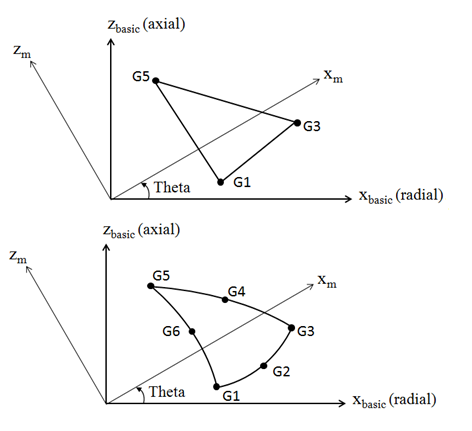CTAXI |

|

|

|

|
|
CTAXI |

|

|

|

|
Bulk Data Entry
CTAXI – Axisymmetric Triangular Element Connection
Description
Defines an axisymmetric triangular cross-section ring element for use in linear analysis.
Format
(1) |
(2) |
(3) |
(4) |
(5) |
(6) |
(7) |
(8) |
(9) |
(10) |
CTAXI |
EID |
PID |
G1 |
G2 |
G3 |
G4 |
G5 |
G6 |
|
|
Theta |
|
|
|
|
|
|
|
|
|
Field |
Contents |
EID |
Unique element identification number. No default (Integer > 0) |
PID |
A PAXI entry identification number. Default = EID (Integer > 0) |
G1,G3,G5 |
Identification numbers of connected corner grid points. Cannot be omitted. No default (Integers > 0, all unique) |
G2,G4,G6 |
Identification numbers of connected edge grid points. Cannot be omitted. No default (Integers > 0, all unique) |
Theta |
Material orientation angle in degrees. Default = 0.0 (Real) |
| 1. | All the grid points must be located in the x-z plane of the basic coordinate system with x = r > 0, and ordered consecutively starting at a corner grid point and proceeding around the perimeter in either direction. |
Corner grid points G1, G3 and G5 must be present. The edge points G2, G4 and G6 are optional. If any of the edge points are present, they all must be used.

CTAXI definition
| 2. | The continuation is optional. |
| 3. | If the PAXI entry referenced in field 3 references a MAT3 entry, material properties and stresses are always given in the (xm, zm) coordinate system shown in the figure above. |
| 4. | A concentrated load (for example, the load specified on a FORCE entry) at a grid Gi of this element denotes that applied onto the circumference with radius of Gi. For example, in order to apply a load of 200N/m on the circumference at Gi which is located at a radius of 0.4m, the magnitude of the load specified on the static load entry must be: |
(200 N/m) * 2![]() * (0.4m) = 502.655N
* (0.4m) = 502.655N
| 5. | CTAXI and CTRIAX6 elements cannot be used simultaneously in an input model. |
| 6. | This card is represented as an element in HyperMesh. |
See Also: